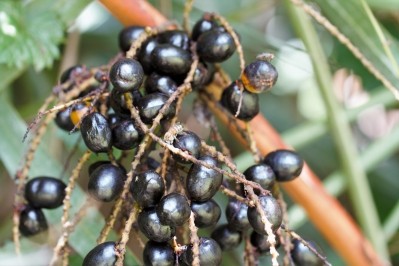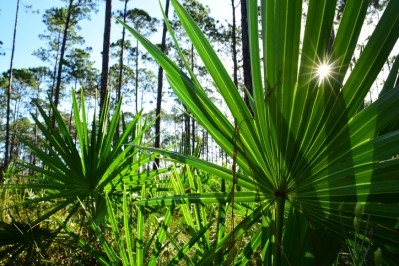Saw Palmetto supply: ABC-SHP webinar explores adulteration and sustainability

Extracts from the berries of saw palmetto (Serenoa repens) are reported to improve symptoms related to benign prostatic hyperplasia (BPH) in human clinical trials, and dietary supplement products containing saw palmetto berries and/or their extracts are among the top-selling botanical dietary supplements in the United States — ranking 14th in the mainstream market (supermarkets, drug stores, grocery stores, etc.) and 13th in the natural foods channel with a combined $38.47 million in sales for both channels, according to the latest HerbalGram Herb Market Report for 2019.
“Normally the volume is in the 4,000 to 8,000 metric ton range, but that could double, depending on the year,” explained Stefan Gafner, Chief Science Officer of the American Botanical Council and Technical Director of the ABC-AHP-NCNPR Botanical Adulterants Prevention Program (BAPP), during the webinar, Saw Palmetto: A Conversation on Sustainability, Quality, and Authentication, which was hosted by the Sustainable Herbs Program’s Ann Armbrecht.
“It seems that there are enough berries grown and harvested in an average year that can supply the market. From the point of view of sustainability, there is enough saw palmetto growing to sustain the market,” said Dr Gafner.
“There are some years when that is not the case, because saw palmetto is susceptible to environmental changes,” he added. “In 2018, there was extensive rain that interrupted the flowering period and led to a substantial drop in berries. In early September 2018, the average price was three times higher than the average price the year before.”
As a result, adulteration has become more commonplace.
“Saw Palmetto extract is particularly vulnerable to adulteration”
According to a 2019 BAPP Laboratory Guidance Document (LGD), admixture or substitution with berries from related species of the palm family, such as dwarf palmetto (Sabal minor), queen palm (Syagrus romanzoffiana), and Everglades palm (Acoelorrhaphe wrightii) appears to be rare.
More common is the substitution or dilution of saw palmetto extracts with vegetable oils or designer fatty acid blends from plant or animal sources to attempt to mimic saw palmetto’s fatty acid composition.
“Saw Palmetto extract is particularly vulnerable to adulteration,” said Dr Gafner. “One of the reasons is that it’s relatively easy to mimic the chemical composition of Saw Palmetto extracts. Most people quantify fatty acids. These are chemicals that you find in all vegetable oils, so if you use sunflower oil or a coconut oil or a canola oil so if you mix and match them at the right ratios you get something that looks like the fatty acid profile of saw palmetto.
“Also, the risk of getting caught is relatively low. Sunflower oil or coconut oil don’t represent a health risk, so there’s not really a big incentive for authorities to go after saw palmetto adulteration. I haven’t seen much enforcement.”
Supply chain and sustainability
The Saw Palmetto harvest in 2019 rebounded however, and was a “bumper crop”, said Umasudhan Pal, CEO at Valensa International.
The company, which is headquartered in Florida, introduced a supply chain program several years ago, built around four key pillars of purity, traceability, sustainability, and responsibility, he said.
“We look at crop mapping and monitoring, crop management, and crop security,” added Pal.
By monitoring a range of variables, the company came up with a crop monitoring index. The index, he said, looks at crop volumes and the factors that affect this volume, including weather, pollination, crop diseases, soil conditions, and so on.
“Based on the crop index, this year [2020] was 60% of the normal crop. Last year was 125% plus. 2019 was a bumper crop,” said Pal.
Harvesting
The actual harvesting of Saw Palmetto berries is not easy, explained Steven Foster, ABC Board Member, who said, “describing saw palmetto harvesting as wild crafting is like describing coal mining as stone sculpting. It is a really hard job.
“This is very daunting, back-breaking work. Saw palmetto fruit in August and September in the heat and humidity of Florida. Eastern Diamondbacks like to live under the plants, so you always have to careful and mindful.
“This is not an easy job. The saws on the fronds on the Saw Palmetto are very difficult. They cut you. They cut your clothes,” added Ed Fletcher, President & COO at Native Botanicals, Inc.
Once the harvest is completed, the berries are driven to the buying stations, explained Fletcher. These are all over Florida, but the greatest concentration is in and around Immokalee. The buyers weigh and grade the berries.
Fletcher added that industry efforts in the mid-1990s led to Saw Palmetto being listed as an agricultural crop, which gave the business legitimacy and the opportunity to protect the crop. In 2017, the State of Florida classified it as a commercially exploited plant, and therefore it now requires permits.
The majority of the harvest comes from private land, and you have to have permission.
Most mature berries go for extraction, said Fletcher, but there is a market for powdered berries, about 10% of the total harvest, and they will take some of the less ripe material.
Foster added that berries are picked at various levels of ripeness, so-called green-ripe, orange-ripe, and fully black-ripe.
“There’s an opportunity for industry like the American Herbal Products Association to educate pickers on the right stage of ripeness for a better quality of product,” said Foster.
Valensa’s Pal added: “Sustainability is about all the key stakeholders and preserving Mother Nature. It has to all go hand in hand.”
To watch the full webinar for free, please click HERE.
















